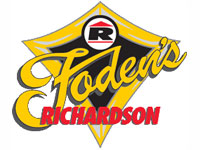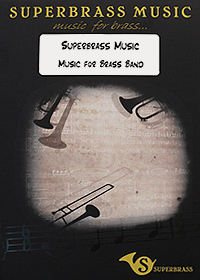Fodens Richardson Band
24-Feb-2006Conductor: Mike Cotter
Winsford
Saturday 18th February
 When a northern funny-man tells you that something is the future you have to sit up and take note. Just ask Iceland (the shop not the country) about sales of Cheese-cake and Garlic-bread since Peter Kaye started including references to these ‘future' foods in his act. When however that funny-man is none other than Alan Wycherley and he also promises the prospect of the best band concert there's ever been, it's too much for 4BarsRest to resist and we were soon on the M6 motorway to Winsford in South Cheshire.
When a northern funny-man tells you that something is the future you have to sit up and take note. Just ask Iceland (the shop not the country) about sales of Cheese-cake and Garlic-bread since Peter Kaye started including references to these ‘future' foods in his act. When however that funny-man is none other than Alan Wycherley and he also promises the prospect of the best band concert there's ever been, it's too much for 4BarsRest to resist and we were soon on the M6 motorway to Winsford in South Cheshire.
Now, the idea of themed concerts is certainly not a new one in the banding genre, for years bands have presented Nights at the Opera/Classics/Proms with great success. Mike Cotter is determined to move the genre on to the next level, using such themed concerts with the addition of light shows, theatrical sets, a professional compere and musical interludes between band numbers. Mike has been involved with bands since the late 60's when he played 2nd Euphonium with the CWS (Manchester) Band so he knows a thing or two about concerts and has recently spent time writing, producing and directing extravaganzas such as the one we were here to see – A Night at the Movies.
When they took to the stage, in their "change" kit of black shirts, or tops for the ladies, the band confirmed to the suspecting audience that this concert was going to be unlike any other they'd seen before. After a brief introduction for the band and welcome from Master of Ceremonies John Maines, we were off, starting with a brisk rendition of There's No Business Like Show Business, not from the 1950 musical Annie Get Your Gun as advertised in the souvenir programme but the 1954 film of the same name. Such a brisk start in fact that a few of the band seemed left behind in the first few bars. However the tempo was loyal to that of the original song so before long the proverbial foot was tapping along (and didn't stop all night).
Up next James Bond and a great selection of the most famous theme tunes. John Barber's sublime trombone playing in Nobody Does it Better from the 1977 The Spy Who Loved Me was a highlight, as was the playing of Tim Bateman on Bass Trombone.
Literally from the sublime to the ridiculous next, with George Thackary dressed as Dorothy Gale (in full gingham dress, pigtails and, from this reviewers seat, shaven legs!) to play Over the Rainbow from the 1939 film The Wizard of Oz. George has the reputation of having one of the finest sounds in the UK and this was evident from his first note to his last; he made the solo, so often pulled around out of recognition, songlike in quality. He also might gain a reputation based on that set of pins!
After a quick ride on a bike with E.T, complete with noisy revolving lights in the quietest section, we moved on to the first disappointment of the evening. Sydney Pollack's star cast movie Out Of Africa has a great soundtrack, composed in the main by John Barry and is a best-seller in its own right. However the title track (subtitled I Had A Farm In Africa) draws upon the expansive sounds of a large symphony orchestra with huge string section and this arrangement, clever as it was, never transported us to the plains of Africa, despite terrific playing from the cornet and euphonium/baritone sections.
Next up Bette Midler in the guise of Helen Fox, Glyn Williams and Mark Wilkinson in the hit song from the 1988 film Beaches, Wind Beneath My Wings.
John Maines introduced the next number by telling us that "…in 1977, as a 12 year old, this film caught my imagination…" Now, either John had a massive paper round as a lad or that particular bit of script needs an edit. The playing of the main themes from Star Wars however was absolutely incredible and with eyes closed this listener could have been in the front of the Empire cinema with that famous text "A long time ago in a galaxy far, far away…" disappearing up the screen. Once again the horn section, led by George Thackary, was terrific in the love theme and the return of the main theme found Alan Wycherly with a real high note lip on him.
Think of brass bands, think of films; inevitably Brassed Off had to make an appearance. Very cleverly the lights were dimmed and miner's helmets complete with pit lights were worn by all members in this performance of Danny Boy. What should have been an emotional moment, we all know what was happening in the film at this point, was slightly marred by a someone in the bass section thinking they were at the end of the second half and looking for the planes about to bomb the dams; a great impression of a wandering searchlight. Also a strange arrangement that due to the tempo selected perhaps, or instrumentation used never got the hairs on your neck standing up. Great band sound but an opportunity missed.
To complete the first half the band chose to play The Gael, from the 1992 film Last Of The Mohicans. Written by Scottish composer and song-writer Dougie Maclean and edited by Trevor Jones for the soundtrack of the film, the music takes the form of a slow theme, followed by a laid-back reel which is then joined by the slower tune again to build to a climax. All was working very well until the lower band, with the slow tune joined the front row with the reel. The balance wasn't quite right. The other payers were obviously blowing but at this point the front row moved from Stradivarius violins to Vanessa Mae electric fiddles with the amps turned up to 11. It was however an exciting end to the first half.
After what must have been 15 minutes of all players applying cold compresses to their lips the band resumed and sadly, in our opinion, missed another opportunity to make magic. Hans Zimmer's soundtrack to Gladiator is another million seller with the opening three tracks (Progeny, The Wheat, The Battle) combining to make an opening unlike any other. These three tracks have been cleverly combined by Sandy Smith to create a single movement from the Zimmerman score. The playing was superb with Tim Bateman again standing out as a player who can cut through even the biggest sounding band with fat, plum notes at ridiculous octaves. However if any piece called for darkness with a light show and the copious amounts of dry ice that had been used all night this was it. Instead we had dimmed lights, no lights to speak of but we did have 2 gladiators at the front of the stage, dressed in full Roman regalia.
Unfortunately one of them looked like he really had been to Gladiator School, and would had probably won, whilst the other looked like he was still at school! After menacingly walking across the stage to swap places with each other they then……..menacingly walked back. We were all waiting with baited breath for the fight, such was the intensity of the stares from "Big" gladiator we knew it would kick off any minute. And it did, with, until then unseen ferocity, they…..swapped places again. Whilst this didn't detract from the immense arrangement and playing one does question what it added. Nothing but a distraction is our opinion.
Next Helen Fox showed why she's regarded as one of the best, if not the best, Flugel Horn players in the country with a performance of Andrew Lloyd Webber's Don't Cry For Me Argentina that can only be described as elegantly perfect. Dressed in a simple white dress on a balcony adorned with the Argentinean flag Helen became Maria Eva Duarte de Peron or Evita as she is universally known. Caught in a single spotlight and casting a perfect silhouette, the performance was mesmerising and a real highpoint in the evening.
After a whip through John Barry's Born Free and the ubiquitous Disney Fantasy in which it was obvious this front row practise their scales, we then arrived at a convent in San Francisco, via Las Vegas, and met up with Sister Mary Clarence, Sister Mary Robert and Sister Mary Lazarus – previously the bands trombone section in a full costumed rendition of I Will Follow Him from the 1992 film Sister Act, complete with introductory act from 9 attractive ladies dressed in habits. The trombone section, when they arrived on stage, looked more like Taliban womenfolk than sisters of the cloth, the habits resembling traditional bhurkas. However John Barber, Gareth Westwood and Tim Bateman entertained the audience with some great playing and a short, but well rehearsed, dance routine of their own.
It has been said that Samuel Barber's Adagio for Strings amply demonstrates two principles: Some of the greatest ideas are essentially quite simple, and not everything popular is junk. Since being composed in 1936, initially as the second movement of a string quartet and, after it's first performance by Toscanini and the NBC Orchestra in 1937, its haunting melody with suspensions, clashes and discords, resolving into peaceful harmony has been used in films such as Platoon (as quoted in the programme), A Clockwork Orange, The Elephant Man, Lorenzo's Oil; it's been used at the state funeral of two presidents of the US (Franklin Delano Roosevelt and John F. Kennedy), as well as at those of Princess Grace and Rainier III, Prince of Monaco; It has also been modified into an eight-part choral work called Agnus Dei ("Lamb of God"), a favorite of choirs all over the world.
Sadly it's also been arranged for Brass Band. This doesn't work and despite a brave performance from Fodens it left us feeling that no brass band could adequately capture the intensity required to truly perform this masterpiece. One plus point was the emergence of the bass section, ably led by Les Neish, who up until this point had been mainly inconspicuous behind the framing curtain on the Winsford stage. Their warm sound providing a real foundation for the band to build upon.
Straight away though we were back to a performance level of the highest order with a superb rendition of The Dambusters from the film of the same name. The story of 617 squadron's flight to drop the Barnes Wallace designed "bouncing bombs" in Operation Chastise (the Dambusters Raid) to attack the Möhne and Eder dams in the Ruhr area in May 1943 starred Richard Todd and Sir Michael Redgrave but is probably equally well remembered for the pastiche of a German soldier catching the bombs dressed as a goalkeeper used by Carling to advertise lager in the late 80's. During this piece we saw probably the most effective use of the vast array of automatic lights and lighting shows of the whole evening. What a tempo too!
Tara's Theme from the 1939 film Gone With The Wind was introduced as the finale but clearly wasn't, as the programme listed the 1812 Overture as our final piece. Unfortunately Tara's lips were a little bit tired by now and in one or two places this showed.
Tchaikovsky's Solemn Overture 1812 is a belting finisher but, having played seventeen lip busting pieces before hand, we weren't exactly sure what to expect. It was composed in 1882 and in essence is a piece of program music. It opens with the somber tones of a Russian Church chant, recalling the declaration of war announced at Church services in Russia, and is then immediately followed by a solemn chant for Russian success in the war. A theme of marching armies follows, carried out by the horns. The French national anthem La Marseillaise reflects the French victories in the war and the capture of Moscow in September 1812. The Russian folk dance theme commemorates the battle beating back Napoleon. The retreat from Moscow late in October 1812 is reflected by a diminuendo.
The firing of cannon reflects the military advances toward the French borders. With the end of the conflict over the peal of bells and fireworks celebrate victory and the liberation of Russia from French occupation. To our great delight, as if this was the first piece of the night, Fodens did what only the top handful of bands in the country can do and raised their game to give an almost definitive version of this war horse, including pyrotechnics that clearly shocked Principal Cornet Mark Wilkinson so much that he took his cornet off his lips for the first time all night! Unfortunately there was so much smoke that we couldn't see or hear Mark Landon who was, apparently, giving a virtuosi performance on bells.
That was it – it was over. An amazing concert, directed superbly by the unobtrusive but always in control Mike Cotter. Fodens were in incredible form; very, very few bands could have performed those pieces to such a high standard as standalone items, let alone one after the other in a two and a half hour concert. The idea of music being used between tracks from the band made the evening feel more laid back; quiet talking was possible and attempts to sing the song they'd just heard, normally with little success, made the listener feel part of the performances.
This was apparently the first attempt at this particular show and it was 95% right. The lighting team was, in the main, sympathetic and clearly understood the music that they were embellishing. With a huge array of lights at their disposal they had obviously invested considerable time and effort in getting it just right. The pyrotechnics, amazingly, were actually in time with the music, underlining the professionalism of the team – this was no DIY amateur affair. Some of the pieces added little despite being taxing – these need further examination. As the show couldn't be rehearsed in situ until the day, the band and production team had rehearsed together for the first time all Saturday afternoon, further testament to the endurance of the band who were rewarded with a larger and possibly younger audience than they would normally expect at this, their "local" venue.
According to Alan Wycherley there are plans to take this show on the road and perform at some of the more popular venues around the UK. It's certainly one to look out for. If this is the future then the future really is bright.
As for being the best band concert ever – it's close. Probably Black Dyke at the Tattershall Sales Ring in 1985 with John Clough and Phillip McCann on their feet just edges it for us but it is close, very close.
Dennis Amiss.









